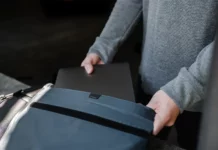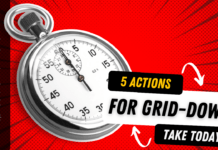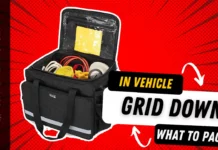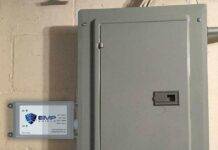Today, we’ll be covering the top 5 most important actions you can take right now to prepare yourself and your loved ones for a grid-down situation resulting from an electromagnetic pulse or EMP. We’ve included links in the description for direct access to the products or informative websites mentioned in this video.
Today, the threat of an EMP seems to be increasing daily, as tensions rise between countries capable of producing nuclear weapons, along with an uptick in solar flaring and coronal mass ejections (CMEs) occurring from our current solar cycle.
No matter the cause, an EMP event could disrupt the power grid in any country worldwide, potentially leading to total grid destruction in certain cases.
In fact, the Ready.gov website has an entire section devoted to providing information on how to prepare for a massive power loss due to “space weather.”
Here’s our list of 5 actions you can take today to prepare for a grid-down situation resulting from an EMP event:
Number 5: Transportation. In the event of an electromagnetic pulse (EMP), vehicles with electronic components and systems would likely be affected. While most cars would survive, there’s a chance many may no longer run.
Modern vehicles heavily rely on electronic systems for ignition, fuel injection, transmission control, and more. An EMP could disrupt these vital electronic components, rendering the vehicle inoperable.
This includes electric vehicles, as they rely entirely on electronic systems for propulsion, charging, and control.
Many motorcycles and scooters use electronic fuel injection, ignition systems, and other electronic components. An EMP could prevent them from starting or running correctly.
Older vehicles with minimal electronic components, such as classic cars and certain military vehicles, might be less affected by an EMP. These vehicles rely more on mechanical systems and could potentially remain operational after an EMP event.
If an older vehicle isn’t an option for you, you can purchase an EMP Shield, a small device that can be installed in your modern vehicle. It ensures your vehicle operates after an EMP, allowing you to get home after an event or obtain supplies when others cannot.
For those in urban settings, consider getting a bike as an alternative to public transportation. Most cities have bike shops, and if those bikes are out of your budget, check local stores like Walmart or area Goodwill stores. You should be able to find a reliable bicycle that can be fixed up for emergency use.
Number 4: Power. If the power grid goes down or is damaged by an EMP, it could take days, weeks, or possibly months for power to be restored.
Each hour without power increases the risk of food spoilage in your refrigerator and freezer. A grid-down situation due to an EMP could also damage electronic devices like cellphones, radios, and televisions.
Even electronics functional after an EMP still need a power source to operate.
While protecting and powering all everyday electronics involves several steps, you can take action today by acquiring a solar power generator.
Even a small solar power generator, such as a Jackery, can power lights and small electronics. It’s useful for USB radios to keep updated on news and updates, as well as for USB lighting and entertainment devices, keeping morale high.
Even in inner-city apartments, solar panels can be used to charge the generator daily.
A small solar generator like the Jackery portable power station can be purchased online today for a couple hundred dollars.
Number 3: Personal Security. Depending on your location, access to personal security tools might be limited or even completely unavailable.
In grid-down situations, local authorities might not be able to ensure personal safety. Your security and that of your family will be in your own hands.
Personal alarms and security whistles might become ineffective, so you’ll need to familiarize yourself with alternative options.
In most US cities, pepper spray is legally allowed for self-defense. In a worst-case scenario, it could provide a slight advantage to escape a life-threatening situation.
Knives are usually permissible to carry, but in urban areas, concealed carry might be necessary, as many metro areas have blade length restrictions.
If local laws permit, a firearm is your best protection. More importantly, knowing how to use this tool safely is paramount. Be sure to check local firearm laws and ensure you know how to use it effectively and safely for self-defense.
At the core of personal security, learn self-defense tactics. In a grid-down scenario, people may become desperate for necessities and target those who possess them. Basic self-defense knowledge could give you an edge to escape such situations. Most self-defense training also emphasizes situational awareness, helping you avoid potentially life-threatening situations altogether.
Number 2: Food. As mentioned earlier, when the power goes out, refrigeration and the ability to keep food frozen are compromised.
The average American household has between 3-7 days of stored food. In a prolonged grid-down situation, you may need many more days, weeks, or even months of food to sustain yourself and your family.
You can start today by gradually purchasing extra food. This includes items like canned goods, dried foods, grains, and other shelf-stable products.
For dried foods like rice, beans, and grains, you can still affordably buy in bulk.
To extend the shelf life of these items, purchase Mylar bags with oxygen absorbers and seal smaller portions of bulk bags for longer-term storage. There are great deals on Mylar bags using the link in the description below.
A food sealer can also help prolong the shelf life of certain foods. A FoodSaver sealer can be purchased online for under $100.
Number 1: Water. On average, a person can survive about 3 to 5 days without water. However, extreme conditions can accelerate dehydration and lead to serious health risks within 1-2 days without water.
Water should be your primary focus in a grid-down situation.
Loss of power can disrupt water pumping stations and treatment facilities, making it challenging to access potable water in urban environments.
Electric pumps are used to maintain adequate water pressure in distribution pipes, ensuring water reaches homes and businesses. A power outage can lead to low pressure or even a complete loss of water flow in some areas.
Prioritize securing a reliable water source in a grid-down scenario.
In cases where the power grid is compromised, your options include purchasing extra cases of water during your grocery runs or acquiring 5-gallon water tanks during your visits to Walmart.
Cases of bottled water can be easily stored in any home. While they might not suffice for long-term water usage, plastic bottles can be carried if you need to leave home, and the containers can be reused.
Beyond drinking, water is essential for cooking and basic sanitation. A practical rule of thumb is to have 1 gallon of water per day, per person. This may accumulate quickly, but having at least 1 week’s worth of water will provide enough time to evaluate your situation and collect more water or relocate to an area with greater water access.
If you reside in suburban or rural areas, you might have access to a well. The same principles for immediate water storage apply. However, if possible, consider installing a hand pump for your well. Hand pumps are generally designed to work effectively at water depths ranging from 25 to 100 feet below ground level. Deep well hand pumps are also an option.
While we could delve into comprehensive preparedness strategies for these 5 aspects, this video focuses on actionable steps you can take today to better prepare for a grid-down event.
Another step you can take today is related to basic fitness. When the power goes out, especially for extended periods, you’ll need extra energy to accomplish the other 5 actions.
Begin by incorporating basic fitness routines into your daily life. You don’t need a gym membership to start preparing. Simple exercises like a few push-ups and sit-ups in the morning or an extended walk in the evening can initiate your journey to better physical shape.
Focus on activities like walking, climbing stairs, stretching, or bodyweight exercises. Start slowly and gradually increase intensity and duration as your fitness level improves.
Of course, consulting your doctor before embarking on a new fitness routine, especially if you have underlying health conditions, is advisable.
So, there are 6 actions you can take today to help yourself and your loved ones prepare for a potential grid-down situation.
We hope you found this list valuable. If you have additional ideas, feel free to share them in the comments. Stay safe and continue to prepare.




















